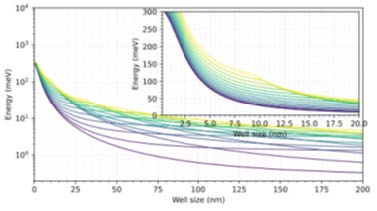Direct Numerical Simulation of Exciton Formation in GaAs Quantum Wells: Effects of Confinement, Donor Impurities and External Magnetic Field
Simulación Numérica Directa de la Formación de Excitones en Pozos Cuánticos de GaAs: Efectos del Confinamiento, Impurezas Donadoras y Campo Magnético Externo
Barra lateral del artículo

Términos de la licencia (VER)

Esta obra está bajo una licencia internacional Creative Commons Atribución-NoComercial-SinDerivadas 4.0.
Declaración del copyright
Los autores ceden en exclusiva a la Universidad EIA, con facultad de cesión a terceros, todos los derechos de explotación que deriven de los trabajos que sean aceptados para su publicación en la Revista EIA, así como en cualquier producto derivados de la misma y, en particular, los de reproducción, distribución, comunicación pública (incluida la puesta a disposición interactiva) y transformación (incluidas la adaptación, la modificación y, en su caso, la traducción), para todas las modalidades de explotación (a título enunciativo y no limitativo: en formato papel, electrónico, on-line, soporte informático o audiovisual, así como en cualquier otro formato, incluso con finalidad promocional o publicitaria y/o para la realización de productos derivados), para un ámbito territorial mundial y para toda la duración legal de los derechos prevista en el vigente texto difundido de la Ley de Propiedad Intelectual. Esta cesión la realizarán los autores sin derecho a ningún tipo de remuneración o indemnización.
La autorización conferida a la Revista EIA estará vigente a partir de la fecha en que se incluye en el volumen y número respectivo en el Sistema Open Journal Systems de la Revista EIA, así como en las diferentes bases e índices de datos en que se encuentra indexada la publicación.
Todos los contenidos de la Revista EIA, están publicados bajo la Licencia Creative Commons Atribución-NoComercial-NoDerivativa 4.0 Internacional
Licencia
![]()
Esta obra está bajo una Licencia Creative Commons Atribución-NoComercial-NoDerivativa 4.0 Internacional
Contenido principal del artículo
Resumen
We present a numerical study of excitonic states in GaAs quantum wells embedded in Al0.3Ga0.7As barriers, focusing on the effects of quantum confinement and donor impurities. Using a finite element method in cylindrical coordinates, we solve the time-independent Schrödinger equation to obtain electron and hole wavefunctions without assuming trial forms. A parametric sweep of the well thickness from 0.1 nm to 20 nm is conducted to analyze confinement-dependent behavior. The exciton binding energy is computed from the Coulomb interaction integral between spatially resolved wavefunctions. Our results show that confinement enhances energy quantization and modulates excitonic coupling, while the presence of a donor impurity significantly increases wavefunction localization and binding energy. Compared to variational approaches, our method offers higher accuracy and greater flexibility for modeling realistic structures, including impurities and complex boundary conditions. This framework provides detailed insight into exciton formation mechanisms and can be extended to model external fields, strain effects, or more complex heterostructures, offering a valuable tool for the design of next-generation optoelectronic and quantum devices.
Descargas
Detalles del artículo
Referencias (VER)
Bastard, G.; Mendez, E. E.; Chang, L. L.; Esaki, L. (1982). Exciton binding energy in quantum wells. Physical Review B, 26(4), 1974–1979. https://doi.org/10.1103/physrevb.26.1974
Bauer, G. E. W.; Ando, T. (1988). Theory of magnetoexcitons in quantum wells. Physical Review B, 37(6), 3130(R). https://doi.org/10.1103/PhysRevB.37.3130
Belov, P. A.; Arkhipov, R. M. (2023). Formation of the stopped polarization pulse in a rectangular quantum well. Micro and Nanostructures, 180, 207607. https://doi.org/10.1016/j.micrna.2023.207607
Belov, P. A.; Khramtsov, E. S. (2017). The binding energy of excitons in narrow quantum wells. Journal of Physics: Conference Series, 816, 012018. https://doi.org/10.1088/1742-6596/816/1/012018
Blancon, J.-C.; Stier, A. V.; Tsai, H.; Nie, W.; Stoumpos, C. C.; Traoré, B.; Pedesseau, L.; Kepenekian, M.; Katsutani, F.; Noe, G. T.; Kono, J.; Tretiak, S.; Crooker, S. A.; Katan, C.; Kanatzidis, M. G.; Crochet, J. J.; Even, J.; Mohite, A. D. (2018). Scaling law for excitons in 2D perovskite quantum wells. Nature Communications, 9(1), 2254. https://doi.org/10.1038/s41467-018-04659-x
Christol, P.; Lefebvre, P.; Mathieu, H. (1993). Fractional-dimensional calculation of exciton binding energies in semiconductor quantum wells and quantum-well wires. Journal of Applied Physics, 74(9), 5626–5637. https://doi.org/10.1063/1.354224
Chuu, D.-S.; Won, W.-L.; Pei, J.-H. (1994). Longitudinal-optical-phonon effects on the exciton binding energy in a semiconductor quantum well. Physical Review B, 49(20), 14554–14563. https://doi.org/10.1103/physrevb.49.14554
de Dios-Leyva, M.; Bruno-Alfonso, A.; Matos-Abiague, A.; Oliveira, L. E. (1997). Fractional-dimensional space and applications in quantum-confined semiconducting heterostructures. Journal of Applied Physics, 82(6), 3155–3157. https://doi.org/10.1063/1.366267
Ferreira, R.; Bastard, G. (1997). Tunnelling and relaxation in semiconductor double quantum wells. Reports on Progress in Physics, 60(3), 345–387. https://doi.org/10.1088/0034-4885/60/3/002
Filinov, A. V.; Riva, C.; Peeters, F. M.; Lozovik, Yu. E.; Bonitz, M. (2004). Influence of well-width fluctuations on the binding energy of excitons, charged excitons, and biexcitons in GaAs-based quantum wells. Physical Review B, 70(3). https://doi.org/10.1103/physrevb.70.035323
Gerlach, B.; Wüsthoff, J.; Dzero, M. O.; Smondyrev, M. A. (1998). Exciton binding energy in a quantum well. Physical Review B, 58(16), 10568–10577. https://doi.org/10.1103/physrevb.58.10568
Ghosh, J.; Parveen, S.; Sellin, P. J.; Giri, P. K. (2023). Recent Advances and Opportunities in Low-Dimensional Layered Perovskites for Emergent Applications beyond Photovoltaics. Advanced Materials Technologies, 8(17). https://doi.org/10.1002/admt.202300400
Grandjean, N.; Damilano, B.; Dalmasso, S.; Leroux, M.; Laügt, M.; Massies, J. (1999). Built-in electric-field effects in wurtzite AlGaN/GaN quantum wells. Journal of Applied Physics, 86(7), 3714–3720. https://doi.org/10.1063/1.371241
Greene, R. L.; Bajaj, K. K.; Phelps, D. E. (1984). Energy levels of Wannier excitons in GaAs-Ga₁₋ₓAlₓAs quantum-well structures. Physical Review B, 29(4), 1807–1812. https://doi.org/10.1103/physrevb.29.1807
Heckötter, J.; Aßmann, M.; Bayer, M. (2024). Rydberg excitons and quantum sensing. MRS Bulletin, 49(9), 948–957. https://doi.org/10.1557/s43577-024-00775-w
Huang, J.; Hoang, T. B.; Mikkelsen, M. H. (2016). Probing the origin of excitonic states in monolayer WSe₂. Scientific Reports, 6(1), 22414. https://doi.org/10.1038/srep22414
Jakubczyk, T.; Delmonte, V.; Koperski, M.; Nogajewski, K.; Faugeras, C.; Langbein, W.; Potemski, M.; Kasprzak, J. (2016). Radiatively Limited Dephasing and Exciton Dynamics in MoSe₂ Monolayers Revealed with Four-Wave Mixing Microscopy. Nano Letters, 16(9), 5333–5339. https://doi.org/10.1021/acs.nanolett.6b01060
Leavitt, R. P.; Little, J. W. (1990). Simple method for calculating exciton binding energies in quantum-confined semiconductor structures. Physical Review B, 42(18), 11774–11783. https://doi.org/10.1103/physrevb.42.11774
Leavitt, R. P.; Littlejohn, M. A. (2015). Excitons in square quantum wells: microscopic modeling and experiment. ArXiv Preprint, arXiv:1508.00480.
Riva, C.; Peeters, F. M.; Varga, K. (2000). Excitons and charged excitons in semiconductor quantum wells. Physical Review B, 61(20), 13873–13881. https://doi.org/10.1103/physrevb.61.13873
Turner, D. B.; Nelson, K. A.; Cundiff, S. T. (2012). Persistent exciton-type many-body interactions in GaAs quantum wells measured using two-dimensional optical spectroscopy. Physical Review B, 85(20), 201303(R). https://doi.org/10.1103/PhysRevB.85.201303
Wang, F.; Wang, Y.; Liu, Y.-H.; Morrison, P. J.; Loomis, R. A.; Buhro, W. E. (2015). Two-Dimensional Semiconductor Nanocrystals: Properties, Templated Formation, and Magic-Size Nanocluster Intermediates. Accounts of Chemical Research, 48(1), 13–21. https://doi.org/10.1021/ar500286j
Wang, G.; Marie, X.; Gerber, I.; Amand, T.; Lagarde, D.; Bouet, L.; Vidal, M.; Balocchi, A.; Urbaszek, B. (2015). Giant Enhancement of the Optical Second-Harmonic Emission of WSe₂ Monolayers by Laser Excitation at Exciton Resonances. Physical Review Letters, 114(9), 097403. https://doi.org/10.1103/PhysRevLett.114.097403
Yücel, M. B.; Sari, H.; Duque, C. M.; Duque, C. A.; Kasapoglu, E. (2022). Theoretical Study of the Exciton Binding Energy and Exciton Absorption in Different Hyperbolic-Type Quantum Wells under Applied Electric, Magnetic, and Intense Laser Fields. International Journal of Molecular Sciences, 23(19), 11429. https://doi.org/10.3390/ijms231911429
Zhong, X.; Ni, X.; Sidhik, S.; Li, H.; Mohite, A. D.; Brédas, J.; Kahn, A. (2022). Direct Characterization of Type-I Band Alignment in 2D Ruddlesden–Popper Perovskites. Advanced Energy Materials, 12(45). https://doi.org/10.1002/aenm.202202333

 PDF
PDF
 FLIP
FLIP







